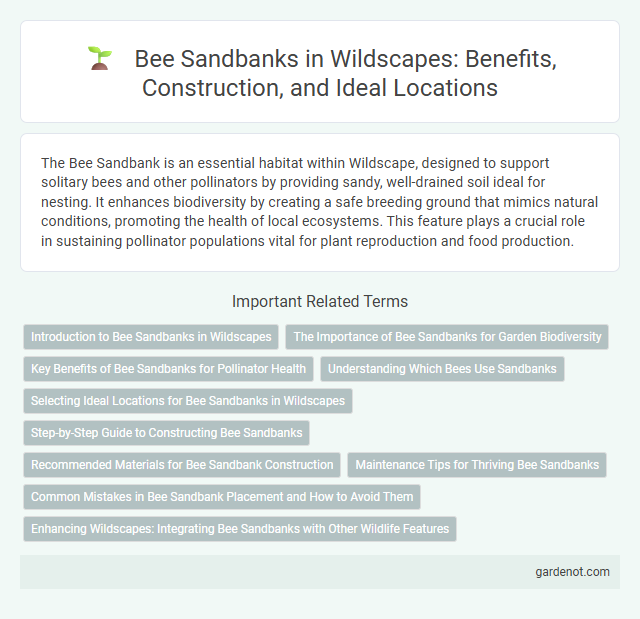The Bee Sandbank is an essential habitat within Wildscape, designed to support solitary bees and other pollinators by providing sandy, well-drained soil ideal for nesting. It enhances biodiversity by creating a safe breeding ground that mimics natural conditions, promoting the health of local ecosystems. This feature plays a crucial role in sustaining pollinator populations vital for plant reproduction and food production.
Introduction to Bee Sandbanks in Wildscapes
Bee Sandbanks in Wildscapes serve as vital habitats supporting diverse pollinator populations. These sandy environments provide essential nesting grounds for solitary bees, aiding in the conservation of wild bee species. Enhancing biodiversity, Bee Sandbanks promote ecological balance through natural pollination processes.
The Importance of Bee Sandbanks for Garden Biodiversity
Bee sandbanks provide essential nesting habitats for solitary bees, which are vital pollinators supporting garden biodiversity. These sandy areas promote the proliferation of native plant species by encouraging effective pollination, enhancing ecosystem resilience. Maintaining and creating bee sandbanks fosters a balanced environment, increasing the overall health and diversity of garden wildlife.
Key Benefits of Bee Sandbanks for Pollinator Health
Bee sandbanks provide essential nesting habitats that enhance pollinator reproduction and biodiversity. Their sandy structure offers optimal conditions for ground-nesting bees, improving colony establishment and resilience. These habitats support pollinator health by increasing access to safe breeding sites, which in turn boosts pollination efficiency in surrounding ecosystems.
Understanding Which Bees Use Sandbanks
Bee species such as mining bees (Andrena spp.) and plasterer bees (Colletes spp.) frequently utilize sandbanks for nesting due to their preference for loose, well-drained soil. These solitary bees excavate tunnels in sandy soils to lay their eggs, ensuring optimal temperature regulation and protection from predators. Recognizing the specific bee species that favor sandbanks helps conservation efforts maintain and restore these critical habitats.
Selecting Ideal Locations for Bee Sandbanks in Wildscapes
Selecting ideal locations for bee sandbanks in wildscapes involves identifying sunny, south-facing slopes with well-drained, sandy soil that supports solitary bee nesting. Proximity to diverse flowering plants ensures a continuous food source, while avoiding areas prone to flooding or heavy human disturbance enhances colony stability. Integrating these conditions promotes thriving bee populations essential for ecosystem pollination services.
Step-by-Step Guide to Constructing Bee Sandbanks
Constructing bee sandbanks involves selecting a sunny, well-drained location with sandy or loamy soil to mimic natural habitats preferred by solitary bees. Begin by clearing the area of vegetation and gently compacting the soil to create stable, vertical or slightly sloped banks that provide exposed sand surfaces for nesting. Maintain the sandbank by removing invasive plants and ensuring the soil remains dry and loose, crucial for the successful habitation of mason and mining bee species.
Recommended Materials for Bee Sandbank Construction
Recommended materials for constructing a bee sandbank include fine, well-draining sand mixed with organic humus to retain moisture while allowing easy burrowing for solitary bees. Incorporating clay particles enhances structural stability, preventing collapse of nests, while avoiding overly compact or waterlogged soil ensures optimal conditions for bee habitation. Natural elements like small twigs and leaf litter can be added around the sandbank perimeter to support local biodiversity and provide additional nesting resources.
Maintenance Tips for Thriving Bee Sandbanks
Regularly remove invasive vegetation and gently aerate the sandy soil to maintain optimal nesting conditions for solitary bees. Provide a south-facing, well-drained area with minimal shade to ensure the sandbank stays warm and dry, promoting successful brood development. Monitor moisture levels after rain to prevent erosion or compaction, preserving the habitat's suitability for native bee populations.
Common Mistakes in Bee Sandbank Placement and How to Avoid Them
Incorrect placement of bee sandbanks often results from choosing overly shaded or damp areas, which can deter solitary bees from nesting. Ensuring the sandbank is situated in a sunny, well-drained location with a gentle slope enhances bee activity and nesting success. Avoid compacted or overly disturbed soil by loosening the sand regularly to maintain optimal conditions for solitary bee species.
Enhancing Wildscapes: Integrating Bee Sandbanks with Other Wildlife Features
Bee sandbanks play a crucial role in enhancing wildscapes by providing essential nesting habitats for solitary bees, which are vital pollinators in ecosystem health. Integrating these sandbanks with other wildlife features such as wildflower meadows, insect hotels, and native shrubs creates a biodiverse habitat that supports a wide range of pollinator species and promotes ecological balance. This holistic approach boosts pollination services, improves plant reproduction, and fosters resilience against environmental stressors within natural landscapes.
Bee sandbank Infographic

 gardenot.com
gardenot.com